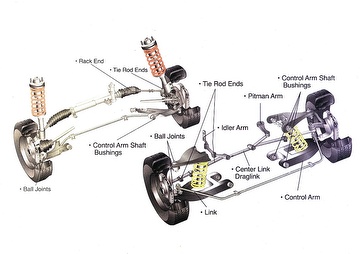Your vehicle’s power steering system is very complex and is perhaps the most overlooked of all vehicle systems requiring regular maintenance. It is an extremely complicated and sophisticated hydraulic mechanism. The system usually contains a power steering pump, steering gear & linkages, drive belts, bearings, valves, hoses and seals. Power steering is a system for reducing the steering effort on cars by using an external power source to assist in turning the wheels.
Most vehicles have power steering and the trend to front wheel drive, greater vehicle mass and wider tires means that modern vehicles would be extremely difficult to maneuver at low speeds (e.g. when parking) without assistance. Laboratory and field testing show that most Power Steering Fluids degrade measurably by 50,000 miles. Therefore, a one time exchange of power steering fluid at 50,000 miles is SUGGESTED — if a service interval is not included in the manufacturer’s maintenance schedule. Additionally, the power steering fluid should be exchanged whenever a system component (pump, hose, rack & pinion, etc.) is replaced.
Power Steering Operation
Power Steering Fluid (PSF)
Power Steering Fluid is one of the hydraulic components in power steering systems. When a fluid becomes oxidized, its resistance to flow is greater and its ability to protect components and transfer pressure is decreased. The most common failure mode of PSF is internal and external contamination. Excess contamination in fluid promotes component wear and can lead to component failures, including seals, shafts and gears.
The steering system has three major components:
(1) the steering wheel and attached shaft in the steering column, which are connected to the steering gear;
(2) the steering gear that increases the mechanical advantage while changing the rotary motion of the steering wheel to linear motion; and
(3) the steering linkage(including the tie rod and tie-rod ends) that carries the linear motion to the steering-knuckle arms.
Manual vs. Power Steering
When the only energy source for the steering system is the force that the driver applies to the steering wheel, the vehicle has manual steering.
When the driver’s effort is assisted by hydraulic pressure from an electric or belt-driven pump, the vehicle has power steering.
Power steering allows manual steering to always be available, even if the engine is not running or the power-assist system fails.
How does the Steering System work?
Most power steering systems work by using a belt driven pump to provide hydraulic pressure to the system. This hydraulic pressure is generated by a rotary-vane pump which is driven by the vehicle’s engine.
Low belt tension, contamination and belt vibration are common sources of belt noise. A screeching or squealing noise that occurs when pulling away from a stop normally indicates a lack of tension; check belt tension and tensioner adjustment.
As the speed of the engine increases, the pressure in the hydraulic fluid also increases. A relief valve is incorporated into the system to prevent over-pressurization in the system.
The pressure is transferred from the pump to the steering gear through high and low pressure hoses. Hoses showing obvious signs of wear such as cracks, cuts, stiffness, bulges, excessive softness or abrasions should be replaced.
Things to watch for
Do not mix size or type (all season, performance, mud and snow) of tires on the same axle
When replacing only two tires on front or rear drive vehicles, it is preferable to place the two new tires on the rear
If radial tires and non-radial tires are mixed on the same vehicle, the radials must be on the rear
Mount tires only on same or approved rim widths
Proper wheel alignment adjusts the angle of the wheels so they are positioned correctly relative to the vehicle’s frame and maximizes the life of your tires
AWD & 4-WD vehicles may require the replacement of all four tires, at the same time, in order to avoid damage to drive-train components.

Preventive Auto Service & Auto Maintenance
by
Tags:

Leave a Reply